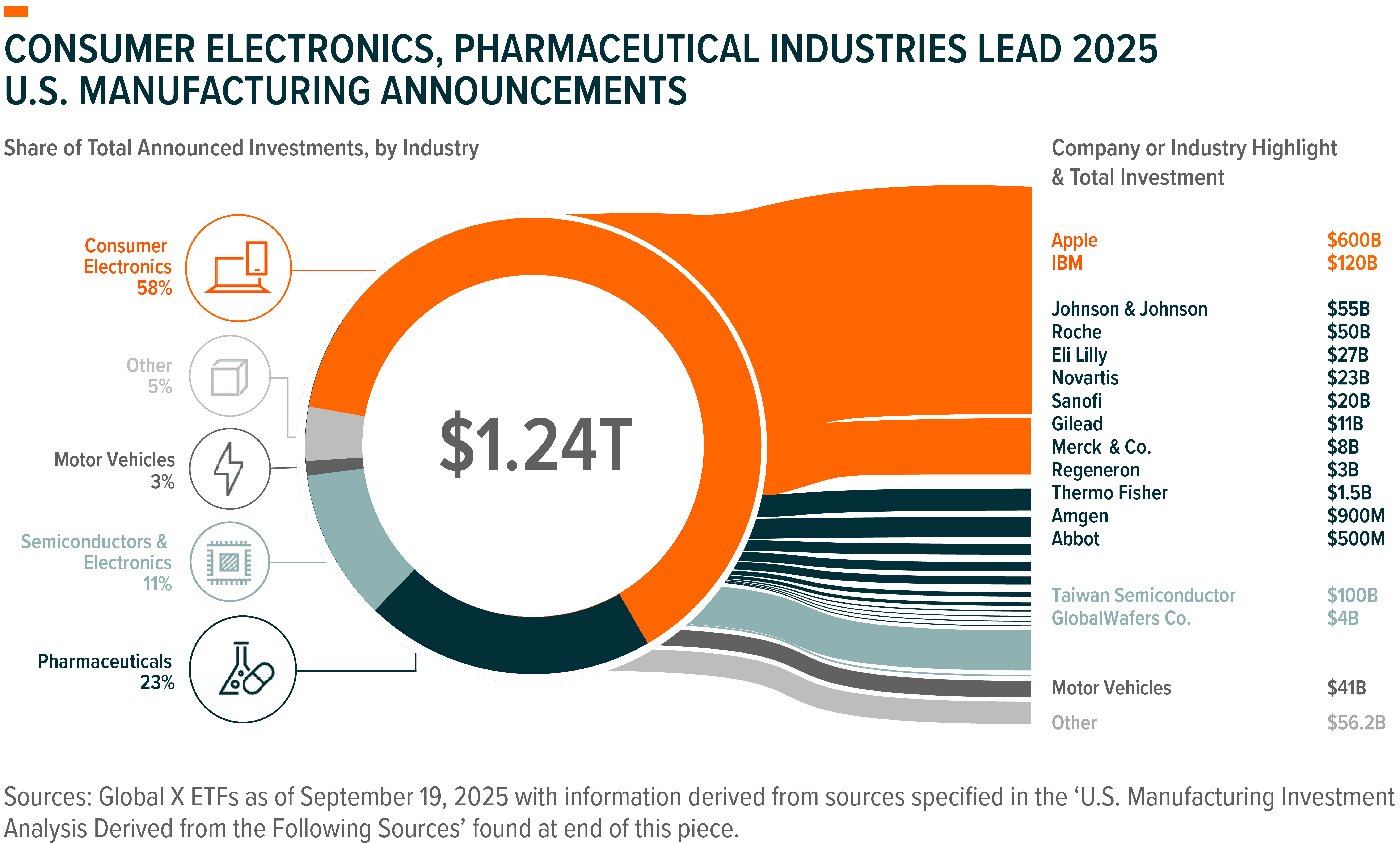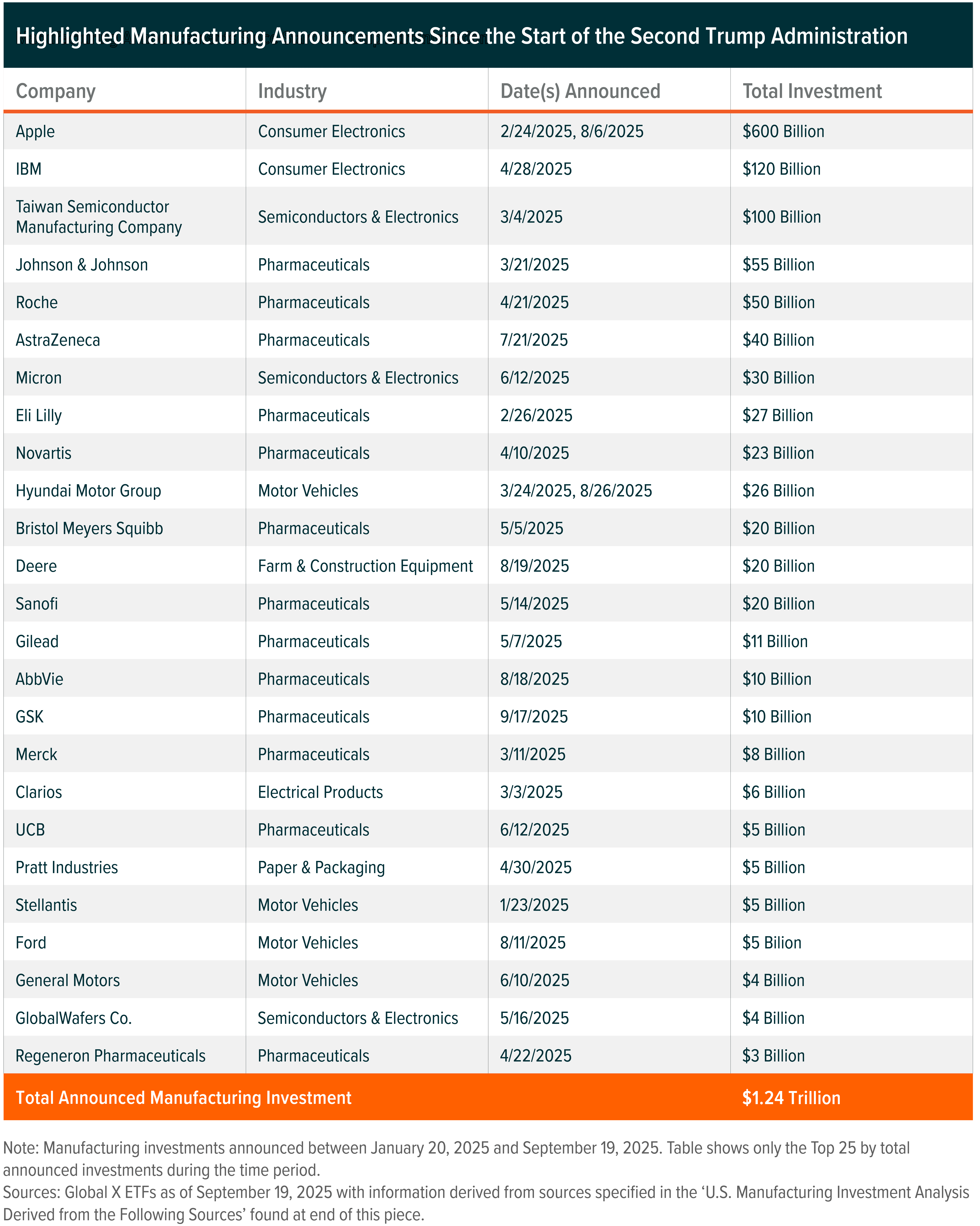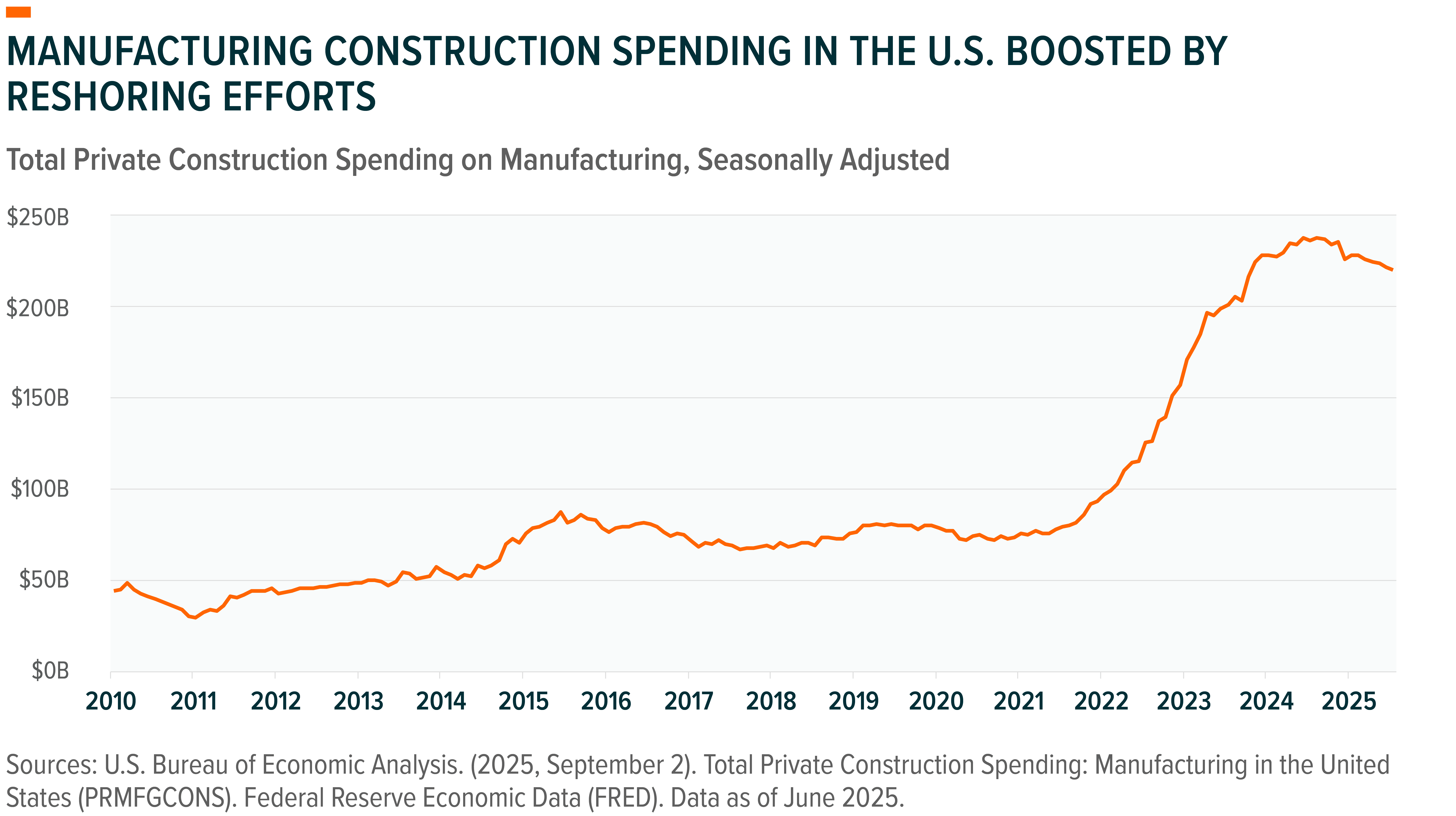The United States is experiencing a manufacturing resurgence, facilitated by a changing federal policy landscape and a shift to companies prioritizing supply chain resilience. Over the first eight months of the second Trump Administration, companies announced over $1.2 trillion in planned advancements towards expanding U.S. production capacity.1 Our analysis indicates that the majority of these investments target the reshoring of strategic industries - primarily semiconductors, electronics, and pharmaceuticals. These investments add on to the more than $750 billion in U.S. manufacturing investments announced under the Biden Administration.2 As these planned manufacturing investments make their way through the development process, we expect significant opportunities to materialize for companies throughout the U.S. infrastructure development value chain, such as construction and engineering services providers, raw material suppliers, equipment suppliers, and industrial transportation service providers.
Key Takeaways
- Between January and September 2025, companies announced over $1.2 trillion in investments towards building out U.S. production capacity – led by electronics, pharmaceuticals, and semiconductors.3
- The increase in planned U.S. production investments could lead to another period of accelerated construction manufacturing spending.
- Building out U.S. manufacturing capacity across industries will likely create significant opportunities for U.S. infrastructure developers, as the construction and operation of large-scale manufacturing facilities requires significant materials, labor, and power.
Announced U.S. Production Investments Span an Increasingly Diverse Set of Industries
The U.S. manufacturing landscape is at an inflection point in 2025, where producing goods in America has become more of a long-term strategic necessity. The implementation of ‘America First’ trade policies under the Trump Administration, including broad-based tariffs, have led to a flurry of planned investments by companies to increase U.S. manufacturing capacity. In total, dozens of large companies announced more than $1.2T in potential new investment from late January through August 2025.4

The consumer electronics industry leads the U.S. manufacturing efforts, although investments in the segment are highly concentrated with most coming from Apple and IBM. In February 2025, Apple announced plans to invest $500B over the next four years into new production capacity and supporting its suppliers throughout the country.5 In August, the company announced an additional $100B towards U.S. manufacturing, with plans to further expand operations across several states with partners such as TSMC, Global Wafers Co., Corning, and Texas Instruments.6 In April, IBM announced $150B towards its U.S. operations, including $120B for expanding its manufacturing capacity.7
The pharmaceuticals industry accounts for nearly a quarter of all announced investments into U.S. manufacturing in 2025. In total, drugmakers announced plans to invest nearly $280B towards building out new production capacity. The largest investments within the industry include Johnson & Johnson, Roche, Eli Lilly, and Novartis. Johnson & Johnson plans to invest $55 billion into the United States over the next four years, including the construction of four new manufacturing facilities.8
Semiconductor producers account for the third-largest share of announced investments in 2025, with nearly $135B in planned spending. This adds onto the more than $300 billion of private investments towards U.S. chip manufacturing that were announced following the passage of the CHIPS Act.9 Taiwan Semiconductor Manufacturing Company (TSMC) has the largest planned investment, including six semiconductor fabrication plants (fabs), as well as packaging and research and development centers.10 In March 2025, the company announced an additional $100B towards expanding U.S. operations, bringing its total up to $165B.11

U.S. Manufacturing Construction Set to Accelerate with New Investment
Manufacturing construction surged across the United States over the past four years due to new or expanded production facilities. Total private construction spending on manufacturing in the United States increased 3x from $76.2B in January 2021 to nearly $230B in January 2025.12 As of July 2025, construction spending on manufacturing accounted for nearly 14% of all private construction spending in the country, up from 6% in January 2021.13,14 The enactment of the CHIPS Act and Inflation Reduction Act in August 2022 were key catalysts for new manufacturing construction prior to the recent implementation of tariffs. However, many reshoring efforts across all industries began even earlier in the decade as a response to rising trade tensions and significant supply chain disruptions due to the COVID-19 pandemic.
Looking forward, we believe that the flurry of announcements in 2025 could generate another period of growth for manufacturing construction spending in the coming years. Even if some of the planned investments do not move forward, the breadth of investment across industries and rising geopolitical risk give us confidence that the reshoring of strategic sectors such as semiconductors or electronics is a structural trend. For example, majority of the world’s AI chips today are made in Taiwan, a key geopolitical chokepoint.15 By 2030, the U.S. could produce up to 20% of these advanced AI chips.16 Similar vulnerabilities exist across smartphones, critical drugs, medical devices, battery systems, defense components, and more. Rising labor costs in emerging markets such as China further erode the economic advantage of offshoring, reinforcing the shift towards domestic manufacturing.17

America’s Manufacturing Growth Requires Substantial Infrastructure Development
Building out manufacturing facilities often requires sizeable resources, including construction materials, engineering, procurement, construction services, and construction labor. For example, Intel, which is building three new semiconductor fabs in the United States, estimates that building a single facility requires 600,000 cubic meters of concrete, 75,000 tons of steel reinforcement, 35,000 tons of structural steel, and 9 million meters of cable. Each factory also requires the removal of more than 1 million cubic meters of soil and rock, with each project requiring an estimated 6,000 construction workers.18 Many of the planned facilities are in remote locations, which can require the buildout of roads and power infrastructure, as well.
In our view, the growth of U.S. manufacturing will also be contingent upon the expansion and modernization of power generation and transmission and distribution infrastructure assets. Production facilities can consume high amounts of power. For example, TSMC’s first fab in Arizona is expected to require 2.85GWh of electricity per day, equivalent to the needs of about 100,000 homes.19 In total, electricity consumption from the industrial sector is forecast to increase 2.3% in 2025 and 3.8% in 2026, compared to 1% growth in 2024 and a 1% decline in 2023.20 Over the long term, U.S. power demand could grow by as much as 50% between year-end 2024 and 2040 due to the increase in manufacturing facilities, as well as the growth in AI data centers and the uptake of electric vehicles.21 Similarly, roads and transportation, ports, distribution centers, water infrastructure and other enabling infrastructure will likely need to advance in lockstep to enable broad re-industrialization.
Conclusion: Growth of U.S. Manufacturing Likely Creating Long-Term Opportunities
A confluence of long-term structural drivers, from trade policy and geopolitical tensions to supply-chain resilience and government incentives, is expected to drive reshoring and potentially record amounts of infrastructure investment. The resulting expansion of the United States’ manufacturing footprint will likely create significant potential opportunities for companies across the entire infrastructure development value chain.
Related ETFs
PAVE – Global X U.S. Infrastructure Development ETF
Click the fund name above to view current performance and holdings. Holdings are subject to change. Current and future holdings are subject to risk.